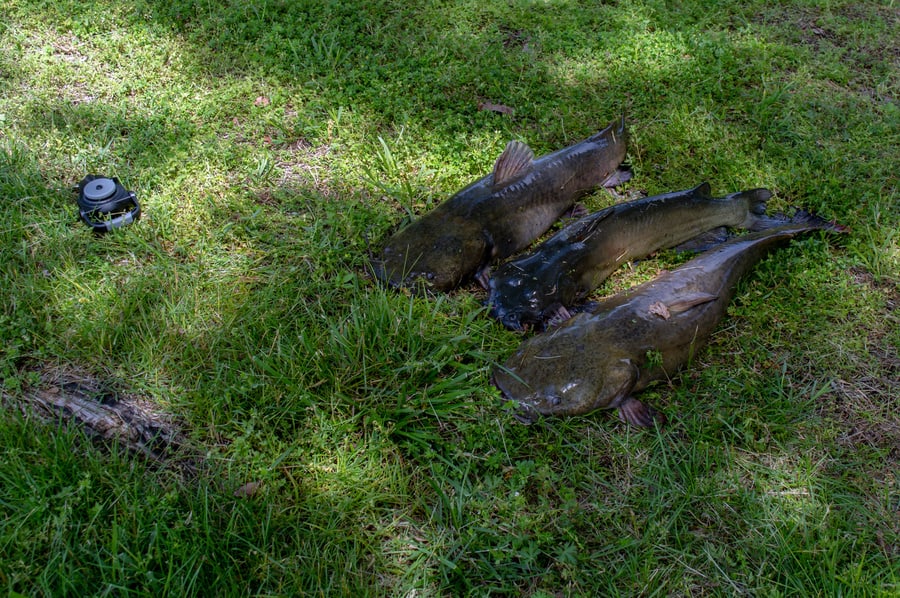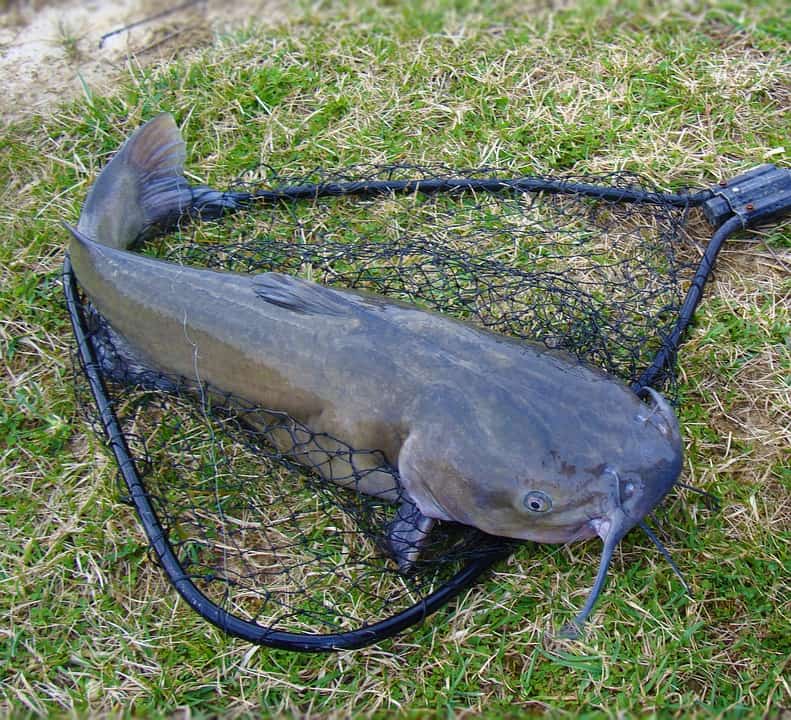


Weather is one of the most crucial factors for catfishing. Handling whatever conditions mother nature dishes out can help you catch more catfish.
Catfish become more active and feed in shallow areas during cloudy, warm weather with stable or slightly falling barometric pressure. In contrast, they retreat to deeper waters and become less active during cold weather or drastic changes in barometric pressure.

The best weather for catfish fishing is when it’s cloudy. Clouds make catfish feel safe to come out and look for food. Warm water temperatures, between 70 to 85 degrees Fahrenheit, also help. Light rain can be good too, because it stirs up the water and gets the catfish moving. Winds from the south or southeast are best. Barometric pressure that is stable or slightly falling also helps catfish bite better.
The worst weather is when it’s too cold or hot. Catfish don’t like water temperatures below 50 degrees or above 90 degrees Fahrenheit. Bright, sunny days can make catfish hide. Strong winds from the north or northwest make it hard to fish. Very high or very low barometric pressure makes catfish less active.
The best time to fish for catfish during the day is early morning or late afternoon. Cloudy skies make catfish active and willing to hunt in shallow areas. Barometric pressure that is stable or falling slightly is best. Winds from the south or southeast at a moderate speed are also good for fishing.
The worst time to fish is around noon when the sun is brightest. Clear skies make catfish hide in deep water. High or very low barometric pressure makes catfish inactive. Winds from the north or northwest can be bad for fishing. Hot water, above 90 degrees Fahrenheit, or cold water, below 50 degrees, will also make catfish less likely to bite.
The best time to fish for catfish at night is right after sunset or just before dawn. During these times, a stable or slightly falling barometric pressure is ideal. Light rain can be helpful because it mixes up the water and makes catfish active. Moderate wind from the south or southeast is also beneficial. Water temperatures between 70 and 85 degrees Fahrenheit make catfish more likely to bite.
The worst time to fish at night is a full moon with clear skies. Catfish tend to hide during these conditions. High or very low barometric pressure makes them less active. Winds from the north or northwest are not good for fishing. Extremely hot or cold water temperatures also make it hard to catch catfish.
In winter, catfish are less active because the water is cold. They prefer deep holes where the water temperature is more stable. A stable barometric pressure is best for winter fishing. Light wind from the south or southeast can improve your chances. A new or crescent moon is better than a full moon for catching catfish.
The best time to fish in winter is midday when the water is slightly warmer. The worst time is early morning or late evening when the water is coldest. Catfish stay in their deep holes and are less likely to bite during these cold times.
In spring, catfish become more active as water temperatures rise. A stable or slightly falling barometric pressure is best for catching them. Cloudy skies and light rain make catfish move to shallow areas to look for food. Winds from the south or southeast help with fishing.
Regarding the moon phase, a new moon or a crescent moon is better than a full moon for catching catfish. The best time to fish in the spring is early morning and late afternoon. The worst time is midday when the sun is the brightest. Catfish move to deeper water during bright days and are less likely to bite.
Catfish are most active in water temperatures between 70 and 85 degrees Fahrenheit in summer. A stable or falling barometric pressure helps them search for food. Cloud cover and light rain are good, making catfish move to shallow areas. Winds from the south or southeast are best for fishing. A new moon or crescent moon is better for fishing than a full moon.
The best time to fish in the summer is early morning or late afternoon. The worst time is midday when the sun is strongest. During this time, catfish move to deeper, cooler water and are less likely to bite.
In fall, catfish start to move to deeper water as temperatures drop. A stable or slightly falling barometric pressure is best for catching them. Cloud cover and light rain make catfish more willing to hunt in shallow areas. South or southeast winds are good for fishing. A new moon or crescent moon is better for fishing than a full moon.
The best time to fish in the fall is late afternoon when the water is warmer. The worst time is early morning when the water is coldest. Catfish move to deeper water during cold times and are less likely to bite.
Catfish move to shallower water when the weather is warm and cloudy. They come to these areas to hunt for food. In hot and sunny conditions, catfish go to deeper water. They find cool spots near underwater structures like logs or rocks. In cold weather, catfish stay in deep holes in the water body.
To catch catfish, consider the weather. On cloudy or rainy days, fish in shallow areas. On sunny and hot days, fish deeper in the water. In cold weather, target the deep holes. Always look near places with cover such as logs or underwater plants. These spots make catfish feel safe.
The best weather for catching flathead catfish is warm and cloudy. Stable or slightly falling barometric pressure makes flathead catfish more active. Winds from the south or southeast are best for fishing.
The worst weather is when it’s very hot or cold. High or very low barometric pressure makes flathead catfish less likely to bite. Strong winds from the north or northwest are bad for fishing.
The best weather for catching blue catfish is cloudy with moderate temperatures. A stable or slightly falling barometric pressure gets blue catfish moving and searching for food. Light rain and winds from the south or southeast are beneficial for fishing.
The worst conditions for blue catfish are bright, sunny days and high or very low barometric pressure. Extremely hot or cold water makes blue catfish less active. Winds from the north or northwest are bad for fishing.
The best weather for catching channel catfish is when it’s cloudy and the water is warm. A stable or slightly falling barometric pressure encourages channel catfish to hunt for food. Light rain and moderate winds from the south or southeast are good for fishing.
The worst conditions are bright, sunny days and extremely hot or cold water temperatures. High or very low barometric pressure makes channel catfish less active. Strong winds from the north or northwest make fishing difficult.

Weather plays a big role in catfish fishing. Cloudy skies and light rain make catfish move to shallow areas to hunt. A stable or slightly falling barometric pressure makes catfish more active. They are in shallow water in warm weather, but in cold weather, they stay in deep holes.
Winds from the south or southeast are best for fishing. For moon phases, a new moon or crescent moon is better than a full moon for catching catfish.
| Water/Air Temperature (°F) | Catfish Location | Fishing Impact |
| Cold (Below 50°F) | Deep holes, river bends | Poor, less active |
| Mild (50-70°F) | Mid-depths, near structures | Fair, somewhat active |
| Warm (70-85°F) | Shallow waters, flats | Good, very active |
| Hot (Above 85°F) | Deep water, shaded areas | Fair, less active |
| Barometric Pressure | Catfish Location | Fishing Impact |
| Rising | Deeper water, slow areas | Poor, less active |
| Stable | Mid-depths, structures | Good, more active |
| Slightly Falling | Shallow areas, flats | Excellent, very active |
| Sharply Falling | Deep holes, river bends | Fair, less active |
| Wind Speed & Direction | Catfish Location | Fishing Impact |
| Calm | Mid-depths, structures | Fair, somewhat active |
| Light (South/Southeast) | Shallow areas, near banks | Good, more active |
| Moderate (Any Direction) | Mid-depths, open water | Fair, somewhat active |
| Strong (North/Northeast) | Deep holes, river bends | Poor, less active |
| Cloud Cover | Catfish Location | Fishing Impact |
| Clear Skies | Deep holes, river bends | Poor, less active |
| Partial Clouds | Mid-depths, near structures | Fair, somewhat active |
| Overcast | Shallow areas, flats | Good, very active |
| Precipitation | Catfish Location | Fishing Impact |
| No Rain | Deep holes, river bends | Poor, less active |
| Light Rain | Shallow areas, flats | Good, more active |
| Heavy Rain | Mid-depths, structures | Fair, somewhat active |
| After Rain | Near inlets, muddy areas | Good, very active |
| Frontal System | Catfish Location | Fishing Impact |
| Warm Front | Shallow, near structures | Good, increased bites |
| Cold Front | Deep, away from structures | Poor, fewer bites |
| Stable Weather | Varied depths | Moderate, consistent activity |
| Post-Front | Transition zones | Improving, gradual increase in bites |
| Sunlight Intensity | Catfish Location | Fishing Impact |
| Bright Sunlight | Deep water, under cover | Poor, fewer bites |
| Overcast | Shallow areas, near structures | Good, increased bites |
| Dusk/Dawn | Shallow and transition zones | Excellent, high bite rates |
| Nighttime | Varied depths, closer to shorelines | Moderate, consistent activity |
| Moon Phase | Catfish Location | Fishing Impact |
| New Moon | Shallow waters, near structures | Moderate, consistent activity |
| First Quarter | Varied depths | Moderate, average success |
| Full Moon | Shallow and transition zones | Excellent, high bite rates |
| Last Quarter | Varied depths | Moderate to Poor, inconsistent bites |
| Season | Catfish Location | Fishing Impact |
| Spring | Shallow waters, near nesting sites | Excellent, high bite rates |
| Summer | Varied depths, often deeper during the day | Good to Excellent, frequent bites |
| Fall | Transition zones, moving to deeper waters | Moderate, fewer bites but larger fish |
| Winter | Deep, stable waters | Poor to Moderate, fewer bites, patience required |
| Weather Changes Catfish Location | Catfish Location | Fishing Impact |
| Sudden Cold Front | Deep holes, river bends | Poor, less active |
| Stable to Light Rain | Shallow areas, flats | Good, more active |
| Heatwave | Deep water, shaded areas | Fair, less active |
| Storm Approaching | Mid-depths, structures | Fair, somewhat active |
Catfish spawn when the water gets warm, usually between 70 and 85 degrees Fahrenheit. They lay their eggs in late spring or early summer. They like quiet spots with a bottom made of mud or sand. Sometimes they use logs or holes in the riverbanks to hide their eggs. Warm water and steady weather help the catfish spawn more easily.
Fishing is good during the spawn if you know where to look. The best places are those quiet spots with mud or sand. You can also find them near logs or holes in the riverbanks. If the weather is cloudy or there is light rain, catfish are more active and easier to catch.
Weather affects what catfish eat. In warm weather, catfish like to eat schooling baitfish like shad. When the water is warm and the weather is stable, they also hunt small fish like bluegill. In cold weather, they prefer food that is easy to catch like leeches and worms. Catfish become more active when it’s rainy or cloudy and hunt for crustaceans like crayfish.
Catfish may stop eating for a while if there is a sudden change in weather. They need time to adjust. But once they get used to the new conditions, they start eating again. Knowing what catfish like to eat in different weather can help you choose the best bait.
Click here to see a breakdown of the best barometric pressure for catfish. Click here to see a breakdown of the best bait colors for catfish.

